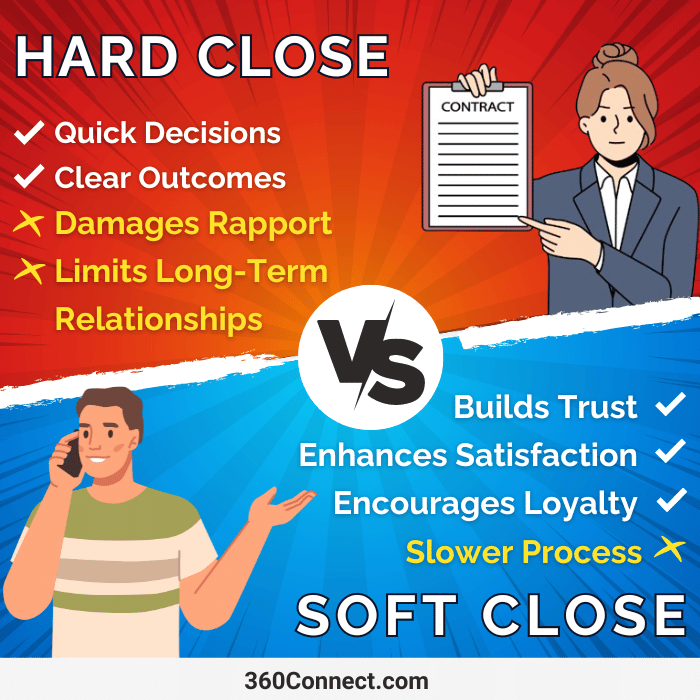To make a soft close, or to make a hard close—that’s the question.
Picture this. You got the prospect on the phone, you’ve talked at length about your products or services, you’ve clearly outlined the benefits, and heck, you’ve even grown to really like the person. Only to get a “no” if you’re lucky, or radio silence. Sound familiar?
In the world of B2B sales, there’s making the sale, and there’s nurturing a lead towards a future opportunity. While nurture campaigns are valuable for long-term engagement, sometimes you need a win now. If you’re looking to increase your conversion rate and shorten your sales cycle, you may need to refine your closing technique.
The first rule of closing is to determine if you will follow a hard or soft close technique. But which is the best? Read on to learn more about the differences between each, the benefits of each, and which is right for you.
Related: Why Persistence is Key to Closing Sales
Soft vs Hard Close
So, what’s the difference between a soft close and a hard close? Take the words at face value: a soft close is a “softer” approach to closing the sale. It includes being more understanding, patient, and flexible with the prospect. It’s about guiding the decision-making process rather than forcing it. You allow the prospect to arrive at their decision naturally, which can build a stronger, trust-based relationship.
In contrast, a hard close is more straightforward and forceful. This technique involves direct language and tactics designed to lead the prospect to make a decision quickly. The hard close is assertive and leaves little room for hesitation, aiming to finalize the deal in the shortest possible time.
Think of a soft close as a coach gently guiding a team to victory, whereas a hard close is more like a referee making a decisive call in the final seconds of the game. Both have their place in sales, but the situation and the type of client often dictate the best approach. Let’s take a closer look at each.

What is a Soft Close?
You know when you’re discussing options with a client, and instead of pushing for an immediate decision, you lay out the benefits and let them ponder a bit? That’s a soft close. It’s all about subtlety – guiding without pushing, suggesting without demanding.
A soft close doesn’t pressure the prospect; rather, it involves gentle nudges that encourage the potential buyer to make a purchase decision on their terms. This method is crucial for creating an atmosphere where the client feels comfortable and in control, leading to more thoughtful and committed decisions. This approach not only respects the client’s pace but also builds a foundation of trust and mutual trust. Let’s dive further into how this technique works and why it’s effective.
When to Use a Soft Close
Knowing when to use a soft close sale technique is vital for ensuring it works. A soft close is particularly effective in situations where the decision-making process is complex and the stakes are high. Check out several scenarios where a soft close approach can be beneficial:
- High-Value Products or Services: When the product or service entails a significant investment or has a substantial impact on the client’s business operations, a soft close allows the decision-makers to weigh the benefits and costs without feeling pressured. This thoughtful consideration helps in making a confident and informed decision.
- Long-Term Business Relationships: In industries where future business depends on sustained relationships a soft close helps in cultivating a relationship and trust that can lead to repeat business and referrals. It positions the salesperson as a partner rather than merely a vendor.
Soft Closing Techniques
To elevate your soft closing strategy, it’s essential to implement effective soft closing techniques that not only persuade but also build significant trust and rapport with the client. Check out 3 techniques you can implement today:
- Guided Discovery: Engage the client in a discussion where you help them uncover their needs and how your product can meet them. This involves asking questions that lead the client to realize the value of your product on their own, making them more likely to commit because the conclusion is their own discovery.
- Future Mindset: Help the client imagine the future benefits they will receive from your product or service. Talk through scenarios where your solution has made a significant difference, focusing on specific outcomes and improvements they can expect. This technique is about helping them see the positive impact in a tangible way.
- Conditional Agreement: This involves suggesting a conditional move forward, where you propose a scenario such as, “If I could address this concern for you, would you be prepared to proceed?” This allows the client to feel in control while gently nudging them towards the sale, as it ties their commitment to your ability to meet their specific needs.
Benefits of Using a Soft Close
- Builds Lasting Relationships
- According to Salesforce, 90% of sales reps on high-performing teams are encouraged to prioritize long-term customer relationships over short-term wins.
- Enhances Customer Satisfaction
- Success Is More Than Just Closing Deals, According to 79% of sales professionals
- Increases Customer Lifetime Value
With all of these advantages in mind, the soft close becomes a powerful tool in the salesperson’s toolbox, especially in scenarios where trust and long-term relationships are key to business success.
Pros and Cons
| PROS | CONS |
| Builds strong relationships | Longer sales cycle |
| Reduces buyer’s remorse | Risk of indecision |
| Encourages repeat business | Les effective in competitive scenarios |
What is a Hard Close?
A hard close is a sales technique where you present the decision as a clear, immediate choice that requires a clear response from the client. This method is direct and assertive, designed to bring the conversation to a decision-making conclusion. Let’s dive further into how this technique works and why it’s effective.
When to Use a Hard Close
You know when you’ve presented all the facts and information about your product or service, and your third call with the prospect is wrapping up and you still don’t have a buy-in?— That’s when you use a hard close.
Identifying the right moment to implement a hard close is crucial for its success. It’s particularly effective in situations where the decision needs to be accelerated or when dealing with clients who appreciate directness—or need a little push. Here are a few scenarios where a hard close might be the best approach:
- Time-Sensitive Offers: When your offer includes a discount or special conditions that are expiring soon, a hard close can create a sense of urgency that motivates the client to act quickly.
- Competitive Situations: In a highly competitive market, where the prospect might be considering multiple options, a hard close can help seal the deal by making your offer stand out as the one they need to decide on now.
Hard Closing Techniques
To maximize your effectiveness in situations that call for a hard close, here are three techniques that can be implemented immediately:
- Now or Never: This classic hard close technique involves presenting the sale as a limited-time offer that the client must act on immediately to benefit from. For example, “This price is only available until the end of the day. Can I go ahead and secure this deal for you now?”
- Direct Proposal: Put a specific proposal directly in front of the client and ask for their commitment. This method is clear and leaves little room for ambiguity. For instance, “We’ve gone through all the details and seen how our product fits your needs. Are you ready to proceed with the purchase today?”
- Summary with a Twist: Recap everything that has been discussed, emphasizing the benefits and unique advantages of your offer, and finish with a direct call to action, like, “Given all the advantages we’ve discussed, moving forward today will immediately start bringing you benefits. Shall we finalize the details now?”
Benefits of Using a Hard Close
- Speeds Up the Sales Process
- Clear Outcomes:
- On the first call, 58% of consumers are ready to discuss pricing, 54% want to know how the product works, 47% want to know the company’s objectives, 44% would like insight into the product’s application in similar businesses, and 37% would like clarity about the value proposition. (LinkedIn)
- Suitable for Certain Markets
Using these techniques, the hard close becomes an essential tool in the salesperson’s arsenal, particularly effective in dynamic market environments where decisions need to be quick and assertive. By understanding when and how to apply a hard close, you can significantly enhance your sales performance and ensure that opportunities are captured efficiently.
Pros and Cons
| PROS | CONS |
| Quick decisions | Potential for increased pressure |
| Clear outcomes | Risk of damaging relationships |
| Effective in high-competition | Not suitable for all sales situations |
Which is Best for You?
Determining the best closing technique depends on your industry, client type, and the specific circumstances of each deal. In B2B settings, where relationships and repeat business are crucial, a soft close often yields better long-term results. However, there are scenarios where a hard close might be necessary to achieve immediate goals.
Sell More with 360Connect
Looking to enhance your B2B sales strategies? Join 360Connect and leverage our expertise in connecting suppliers with high-quality buyers. Join us today and start transforming your sales approach!

